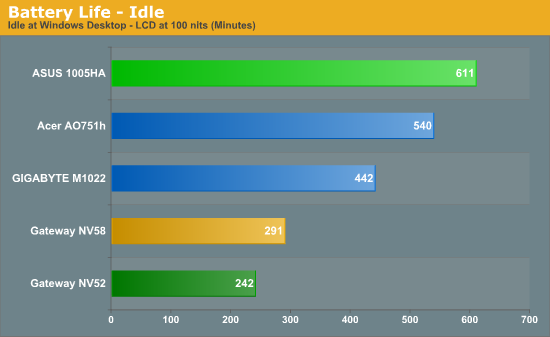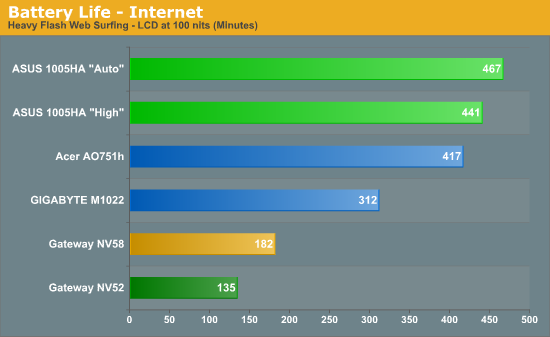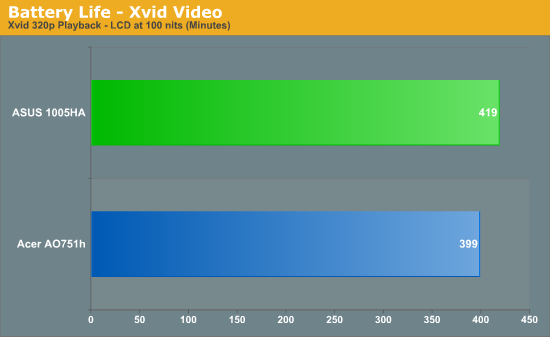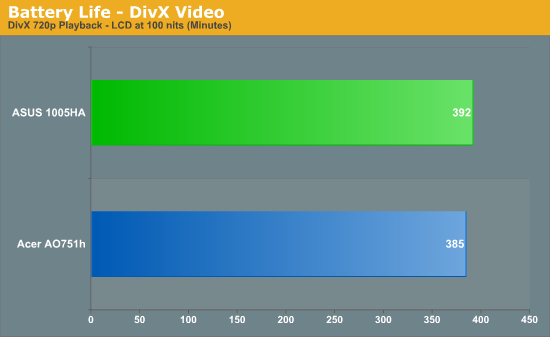ASUS Eee PC 1005HA: Refining the Netbook
by Jarred Walton on August 20, 2009 4:00 AM EST- Posted in
- Laptops
Netbook Battery Life Comparison
We've expanded our battery life testing on netbooks to include many scenarios, at least for this initial look. Since most netbooks don't include optical drives, we ripped our standard test DVD to a hard drive and copied those files over. Obviously there's a benefit to not powering a spinning DVD, but even without that advantage the netbooks provide much better battery life than higher performance laptops. Note also that battery results from the GIGABYTE M1022 are missing in several of the charts; at five or more hours (plus recharge time) per test, we'll be working on getting the remaining results for a couple more days.






Few laptops are able to come anywhere close to the same battery life using a moderately sized battery, and the ASUS 1005HA in our worst-case test (720p DivX playback) still provides 35% more battery life than the Gateway NV58 at idle. Besides DVD playback from the hard drive, we included battery life testing using HD DivX and SD Xvid formats. It's interesting to note that the Acer 751h essentially ties the 1005HA in the DivX test, while it trails in most of the other battery life tests by over 10%. Xvid playback is also closer at only 5%, so the GMA 500 hardware looks like it handles certain video playback scenarios better than the GMA 950.
The ASUS 1005HA by default ships with their Super Hybrid Engine software enabled and set to "Auto" performance. This results in a 12% underclock on battery power, improving battery life in the Internet test by 5.6%. Considering most people buying netbooks aren't ultra concerned with raw performance in the first place, the boost in battery life is a nice extra. If you prefer to run the CPU at stock performance, selecting the "High Performance" setting within the Super Hybrid Engine utility will allow you to do so. You can see the difference between the two settings on the Internet and Relative Battery Life charts above. We ran the remaining tests using the "Auto" setting.
Note that we calibrated all of the test laptops to run at 100 nits brightness (give or take about 5% as many laptops don't provide fine enough control to hit 100 nits exactly). Considering the ASUS 1005HA and the Gigabyte M1022 have virtually identical hardware, we were a little surprised that the battery life relative to battery capacity favored the ASUS 1005HA by 37% (and we'll recheck that score before the final review). Either the battery in the M1022 is flaky or ASUS has done a lot more work in fine-tuning the power saving features on the 1005HA. However, even at idle we didn't reach the advertised 10.5 hours of battery life; we could likely do so if we reduce the LCD brightness to its minimum level, but that's not how most people will use their netbooks.
Overall, despite the 10.5 hour claim being somewhat exaggerated, the 1005HA routinely manages over 6.5 hours of battery life in situations that are known for taxing laptops. You'll have enough time to watch three or four full-length movies without recharging, if that's what you're after. If you stick to less strenuous usage like surfing the web or basic office tasks, getting eight hours or more out of the 1005HA between charges is possible. And you get all that in a package that only weighs 2.8 pounds; that's not something you'll get from a regular laptop.










41 Comments
View All Comments
GeorgeH - Friday, August 21, 2009 - link
Thanks for those perspectives, they're much appreciated. I should probably just go buy one and judge for myself, but $200+ for another doorstop is a little steep. :)I guess for the time being I'll just stick with LGA775/AM2 for my low end needs.
JarredWalton - Thursday, August 20, 2009 - link
Honestly, employees get paid so much more than the computers they use (in all but a few situations) that there's no way I'd recommend "going green" by using Atom-based systems. Let's just estimate that computer-related tasks end up taking 10% more time on average (because multitasking is going to be more limited on such PCs). If you pay someone $20 per hour, you've now wasted $16 per day per employee.Even if it's only 5% and $8 per day, considering a 200W PC uses around $0.16 in electricity during an eight hour shift, cutting that down to an 8W netbook and spending a penny a day on power means that your net costs have still gone up $7.85 per day or more based on lost productivity.
Unless you're power constrained (i.e. in a data center), I think the whole green movement is just a bunch of marketing and political mumbo jumbo. Other "green" CPUs like Core 2 Duo would be far more effective at saving money over the course of the year.
Then again, the biggest source of lost money for companies is probably employees wasting time rather than waiting on their PCs. :-)
yyrkoon - Thursday, August 20, 2009 - link
"Dont expect to spend sub-$400 (not yet anyway) and still expect all the sweet things most commenters are asking for here"I did exactly that, 3 month ago. But it was not a netbook, it was a full blown laptop, even if low powered. $399, free shipping. But, I did add to the cost by having enough foresight to order a 4GB upgrade for it ( $50 ). It will definitely not win any speed records, but at least it *will* run Photoshop, play video without skipping a beat,and play game titles such as GTA San Andreas, or Titan Quest with no problems. All while using a maximum of 40W full load. Idle is only ~17W. Battery life is only ~2 hours, unless you turn it down to energy conservation mode, but that does not bother me one bit. As a matter of a fact, playing no games, and turning the power option down, I have had it last 8-9 hours, but I was not constantly using it like I often do while gaming.
Also, at the same time I was looking at an Asus C2D system, with 4 GB RAM, and one of the newer 512MB/1GB N120 nVidia dedicated graphics cards in it. It was not sub $400, but it was sub $800. This is something that I personally did not ever expect to see, and wished at the time - I had the cash to divert towards. Sadly, I could not :(
Anyhow, this all just lends to what I have been thinking ever since netbooks have been on the market. Which is: "Why even bother". You can get a decent laptop, for close to, or the same price, and get much better performance for your price. These laptop also may not be built like an M1 Abrams, but if you're careful with them, they will last a good long time.
qwertymac93 - Thursday, August 20, 2009 - link
im just waiting for amd's 45nm notebook chips, or at least their dual core neo's. the ones used by hp are custom, i want dual cores for everyone! is it too much to ask for a sempron 140 that uses 10watts or a 240 that uses 25?BigLan - Thursday, August 20, 2009 - link
It looks like the xvid and x264 pass 1 charts have got mixed up - I'd be really suprised in any of the laptops could only manage single digit xvid encoding.JarredWalton - Thursday, August 20, 2009 - link
The x264 encoding graphs are correct; there are no Xvid encoding results - I assume you mean the DivX results? x264 is much more complex than DivX, true, and the second pass in particular can take a very long time. However, the x264 encoding results are for a 720p video (graysky x264 HD Benchmark) while the DivX results are for a 1080p file (done in single-pass, quality-based, preset of 5). The settings and video source definitely have an impact on how quickly DivX encoding will run; a regular single-pass DVD encode is going to be about four or five times as fast in DivX. I'll add the video file information to the charts for clarification.Mithan - Thursday, August 20, 2009 - link
These netbooks are all fine and dandy, but they still have not made one I want.What do I want?
-1.6Ghz+ CPU
-11-12"
-Higher than 1024x600 resolution (1366x768?)
-Preferably an ION chipset, but I can still live with the 950.
There are a few 11-12" Netbooks on the market, but they all have that crappy 1.2Ghz Celeron or ZA520 chip or whatever it is called.
No, I dont want a 15" Laptop, even for the same price.
I guess the wait goes on...
Voldenuit - Friday, August 21, 2009 - link
What about CULV C2Ds and Athlon Neos? Ultraportable, ultrapowerful and ultraaffordable.qwertymac93 - Thursday, August 20, 2009 - link
ever heard of the samsung nc20? its via chip is actually a little faster then the atom n270 despite its low clock speed. the only drawback is its $100 more then most atom notebooks, but it does have a 12 inch screen!Visual - Thursday, August 20, 2009 - link
Well I am a bit more hard to satisfy than you then. the 950 is definitely not enough, i'd not say that even for the GMA 4500... but at least it would have been a step in the right direction.I also am ready to pay a bit more to have it convertible with a simple touchscreen... and pay even double if it were a really good touchscreen - at least 1024 pixels in vertical for adequate portrait operation, with multitouch, decent amount of pressure levels, both pen and finger sensitivity and ability to distinguish between the two.
Bonus points (and price) if it also distinguishes between the two sides of the pen or has a button or two on it, though buttons on the screen bezel can do the trick as well - they just need to be accessible in tablet mode. I think they are a must-have for emulation of hover functionality, where you're not forced to click and/or drag every time you touch the screen to move the "mouse" somewhere - anyone that has ever used a touchscreen probably understands this, so I really can't believe it's not a standard feature of every tablet by now.